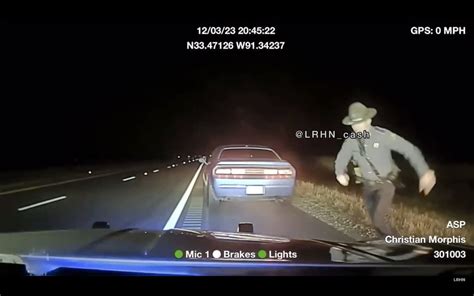
A Dodge Challenger driver fleeing a Florida Highway Patrol trooper crashed at a reported speed of 160 mph in Palm Coast, Florida, resulting in severe damage to the vehicle and injuries to the driver. The incident occurred early Monday morning after the trooper attempted to pull the Challenger over for speeding.
PALM COAST, Fla. – A high-speed chase in Palm Coast ended in a devastating crash early Monday morning when a Dodge Challenger, fleeing a Florida Highway Patrol (FHP) trooper, wrecked while traveling at an estimated 160 mph. The driver, whose identity has not yet been officially released, sustained injuries and was transported to a local hospital.
According to the FHP, the incident began when a trooper observed the Challenger speeding on I-95. The trooper initiated a traffic stop, but the driver of the Challenger refused to comply, leading to a pursuit. The chase continued for a short distance before the Challenger driver lost control of the vehicle and crashed. The exact location of the crash was near Palm Coast, Florida.
“The vehicle was traveling at a high rate of speed and failed to negotiate a curve, resulting in the crash,” stated a preliminary report from the FHP. Images from the scene depict a mangled wreck, with the Challenger sustaining extensive damage. The force of the impact scattered debris across a wide area.
The driver was the sole occupant of the vehicle. Medical personnel arrived at the scene to provide immediate assistance before transporting the driver to a nearby hospital for treatment. The extent of the driver’s injuries is currently unknown.
The FHP is conducting a thorough investigation into the circumstances surrounding the crash. This includes examining the vehicle’s data recorder to determine the precise speed at the time of impact and gathering evidence to understand why the driver initially fled from the trooper. Charges are pending against the driver, and could include reckless driving, fleeing and eluding law enforcement, and other traffic violations.
This incident highlights the dangers of high-speed pursuits and the potentially fatal consequences of reckless driving. Law enforcement agencies often grapple with the decision of when to initiate and when to terminate a pursuit, balancing the need to apprehend suspects with the risk of endangering the public.
High-Speed Pursuits: A Matter of Policy and Risk
The decision to engage in a high-speed pursuit is a complex one, laden with potential risks and liabilities. Law enforcement agencies across the United States have developed policies to guide officers in making these critical decisions. These policies often weigh the severity of the offense, the potential danger to the public, and the likelihood of apprehending the suspect.
Many agencies have adopted stricter guidelines in recent years, limiting pursuits to only the most serious offenses, such as violent felonies. Some policies require supervisors to authorize pursuits, while others mandate that officers terminate a pursuit if the risk to the public outweighs the need for apprehension.
The rationale behind these stricter policies is to minimize the risk of accidents, injuries, and fatalities that can result from high-speed chases. Studies have shown that pursuits can be incredibly dangerous, not only for the suspect and the pursuing officer but also for innocent bystanders.
In this particular case, the FHP will likely review the trooper’s actions to ensure they were in compliance with the agency’s pursuit policy. This review will consider the initial reason for the attempted traffic stop, the speed of the pursuit, the traffic conditions at the time, and any other relevant factors.
The Dodge Challenger: A Symbol of Speed and Power
The Dodge Challenger, known for its powerful engines and aggressive styling, has become an icon of American muscle cars. Its popularity has soared in recent years, appealing to enthusiasts who appreciate its performance capabilities and nostalgic design.
However, the Challenger’s high-performance nature can also contribute to reckless driving behavior. Its powerful engine can easily propel the vehicle to excessive speeds, tempting drivers to push the limits of the law and their own abilities.
The combination of a high-performance vehicle and a driver willing to take risks can be a recipe for disaster, as evidenced by this recent crash in Palm Coast.
Legal Ramifications and Potential Charges
The driver of the Dodge Challenger faces a range of potential charges, depending on the specific circumstances and the laws of Florida. These charges could include:
-
Reckless Driving: This charge typically applies when a driver operates a vehicle with a willful or wanton disregard for the safety of persons or property. Given the reported speed of 160 mph, it is highly likely that the driver will face this charge.
-
Fleeing and Eluding Law Enforcement: This charge applies when a driver knowingly and willfully fails or refuses to stop a vehicle after being directed to do so by a law enforcement officer. The severity of the charge can increase if the driver engages in reckless driving during the pursuit.
-
Speeding: This is a standard traffic violation, but the excessive speed in this case could result in significant fines and penalties.
-
Driving with a Suspended or Revoked License: If the driver’s license was suspended or revoked at the time of the incident, additional charges could be filed.
-
Other Traffic Violations: Depending on the circumstances, the driver could face other traffic violations, such as failure to maintain control of a vehicle or failure to obey traffic laws.
In addition to criminal charges, the driver could also face civil liability for any damages or injuries caused by the crash. This could include lawsuits from other drivers, property owners, or insurance companies.
The Impact on the Community
Incidents like this can have a significant impact on the community. High-speed crashes can damage property, disrupt traffic, and create a sense of fear and insecurity.
The response to the crash also requires the involvement of multiple agencies, including law enforcement, fire rescue, and medical personnel. This can strain resources and divert attention from other important community needs.
Furthermore, the aftermath of the crash can serve as a reminder of the dangers of reckless driving and the importance of responsible behavior on the roads. It can also prompt discussions about traffic safety, law enforcement policies, and the role of government in protecting the public.
Preventive Measures and Road Safety
To reduce the risk of high-speed crashes, a multi-faceted approach is needed. This includes:
-
Education: Educating drivers about the dangers of speeding, reckless driving, and impaired driving. This can be done through driver’s education courses, public service announcements, and community outreach programs.
-
Enforcement: Enforcing traffic laws through visible patrols, speed traps, and other enforcement strategies. This can deter drivers from engaging in risky behavior.
-
Engineering: Designing roads and highways to promote safety. This includes using appropriate speed limits, installing traffic control devices, and improving road surfaces.
-
Technology: Utilizing technology to improve traffic safety. This includes using speed cameras, red light cameras, and other advanced technologies.
-
Legislation: Enacting laws that address reckless driving and other dangerous behaviors. This includes increasing penalties for speeding, reckless driving, and impaired driving.
By implementing these measures, communities can work to create safer roads and reduce the risk of high-speed crashes.
The Psychological Factors of Speeding and Reckless Driving
Beyond the legal and practical consequences, it’s important to consider the psychological factors that contribute to speeding and reckless driving. For some individuals, the thrill of speed provides a sense of excitement and control. Others may engage in risky driving behavior as a way to cope with stress, anger, or frustration.
Some drivers may also be influenced by peer pressure or a desire to impress others. This can be particularly true among young drivers who may be more likely to take risks in the presence of their friends.
Understanding these psychological factors can help law enforcement and public health officials develop more effective strategies for preventing reckless driving. This could include targeting interventions to high-risk groups, providing counseling or therapy to address underlying issues, and promoting responsible decision-making.
The Role of Vehicle Technology
While the Dodge Challenger is known for its power and speed, modern vehicles also incorporate a range of safety technologies designed to prevent crashes and mitigate injuries. These technologies can include:
-
Electronic Stability Control (ESC): This system helps to prevent skidding and loss of control by automatically applying brakes to individual wheels.
-
Anti-lock Braking System (ABS): This system prevents the wheels from locking up during braking, allowing the driver to maintain steering control.
-
Traction Control System (TCS): This system prevents wheel spin during acceleration, improving traction and stability.
-
Airbags: These devices provide cushioning and protection in the event of a crash.
-
Advanced Driver Assistance Systems (ADAS): These systems can include features such as adaptive cruise control, lane departure warning, and automatic emergency braking.
While these technologies can help to improve safety, they are not a substitute for responsible driving. Drivers must still be aware of their surroundings and drive within the limits of their abilities.
The Importance of Accountability
In the aftermath of a crash like this, it is important to hold the responsible parties accountable. This includes the driver, who will face criminal charges and potential civil liability. It may also include other parties, such as the vehicle manufacturer or the road designers, if their actions contributed to the crash.
Accountability is essential for ensuring that justice is served and for deterring others from engaging in similar behavior. It also helps to provide closure for the victims and their families.
The Ongoing Investigation
The FHP is continuing its investigation into the Palm Coast crash. This investigation will involve gathering evidence, interviewing witnesses, and analyzing data from the vehicle’s data recorder.
The results of the investigation will be used to determine the exact cause of the crash and to identify any factors that may have contributed to it. This information will then be used to inform future traffic safety efforts.
The Broader Context of Traffic Safety
The Palm Coast crash is just one example of the many traffic accidents that occur on roads and highways every day. Traffic crashes are a leading cause of death and injury in the United States, and they cost society billions of dollars each year.
Addressing the problem of traffic crashes requires a comprehensive approach that includes education, enforcement, engineering, technology, and legislation. It also requires a commitment from individuals to drive responsibly and to prioritize safety.
By working together, we can create safer roads and reduce the risk of traffic crashes.
FAQ Section
1. What happened in the Dodge Challenger incident in Palm Coast, Florida?
A Dodge Challenger driver, while attempting to evade a Florida Highway Patrol trooper, crashed at a high speed of approximately 160 mph. The driver sustained injuries and was transported to a local hospital. The crash occurred early Monday morning after the trooper initiated a traffic stop for speeding.
2. What potential charges could the driver of the Dodge Challenger face?
The driver could face several charges, including reckless driving (due to the excessive speed), fleeing and eluding law enforcement, speeding, and potentially other traffic violations. If the driver’s license was suspended or revoked, additional charges could be added. Furthermore, the driver may face civil liability for damages or injuries caused by the crash.
3. What factors are considered when law enforcement decides to engage in a high-speed pursuit?
Law enforcement agencies consider several factors, including the severity of the offense, the potential danger to the public, and the likelihood of apprehending the suspect. Many agencies have policies that limit pursuits to only the most serious offenses, such as violent felonies. Supervisors may be required to authorize pursuits, and officers may be mandated to terminate a pursuit if the risk to the public outweighs the need for apprehension.
4. How do vehicle technologies contribute to preventing crashes?
Modern vehicles incorporate technologies like Electronic Stability Control (ESC), Anti-lock Braking System (ABS), Traction Control System (TCS), airbags, and Advanced Driver Assistance Systems (ADAS) to prevent crashes and mitigate injuries. These technologies can help maintain control, prevent skidding, improve traction, and provide cushioning in the event of a crash. However, they are not a substitute for responsible driving.
5. What preventive measures can be implemented to reduce the risk of high-speed crashes?
Preventive measures include education about the dangers of speeding and reckless driving, enforcement of traffic laws through patrols and speed traps, engineering roads for safety, utilizing technologies like speed cameras, and enacting legislation with increased penalties for reckless driving. A comprehensive approach involving education, enforcement, engineering, technology, and legislation is essential for creating safer roads and reducing the risk of high-speed crashes.
Expanded Context and Analysis
The incident in Palm Coast involving the Dodge Challenger is a stark reminder of the potential consequences of reckless driving and the complexities surrounding law enforcement pursuits. While the immediate focus is on the driver and the charges they face, a deeper examination reveals a confluence of factors that contribute to such incidents and the broader implications for traffic safety.
The allure of high-performance vehicles, such as the Dodge Challenger, cannot be ignored. These cars are designed and marketed to appeal to a certain segment of the population that values speed, power, and performance. While owning such a vehicle is not inherently dangerous, it can create a temptation to push the limits, leading to risky behavior. The Challenger, with its powerful engine and aggressive styling, can be particularly enticing for those seeking a thrill.
The decision by the driver to flee from the trooper is another critical aspect of the incident. It raises questions about the driver’s motivations and state of mind. Were they under the influence of drugs or alcohol? Did they have a suspended license or outstanding warrants? Were they simply panicked and made a rash decision? The answers to these questions will likely emerge as the investigation progresses.
The Florida Highway Patrol’s pursuit policy will also come under scrutiny. The policy likely outlines the circumstances under which a pursuit is justified, the procedures that officers must follow during a pursuit, and the factors that should be considered when deciding whether to terminate a pursuit. Investigators will review the trooper’s actions to ensure they were in compliance with the policy and that the pursuit was conducted in a safe and responsible manner.
The high speed of the crash – estimated at 160 mph – underscores the severity of the incident. At such speeds, even a minor error can have catastrophic consequences. The driver’s ability to react to changing road conditions is severely diminished, and the forces involved in a crash are exponentially greater. The fact that the driver survived the crash is remarkable, but it also serves as a testament to the importance of vehicle safety features such as airbags and seatbelts.
The incident also raises questions about the role of technology in preventing crashes. Modern vehicles are equipped with a range of advanced safety systems, such as electronic stability control, anti-lock brakes, and lane departure warning. These systems can help to prevent crashes by assisting drivers in maintaining control of their vehicles and by alerting them to potential hazards. However, these systems are not foolproof, and they cannot compensate for reckless driving behavior.
The aftermath of the crash will involve a thorough investigation by law enforcement, followed by legal proceedings and potentially civil lawsuits. The driver will face criminal charges, and if convicted, could face imprisonment, fines, and the loss of their driving privileges. The driver may also be held liable for any damages or injuries caused by the crash.
Beyond the legal consequences, the incident also has a significant impact on the community. The crash disrupted traffic, damaged property, and created a sense of fear and insecurity. It also required the involvement of multiple emergency response agencies, straining resources and diverting attention from other important community needs.
The incident serves as a reminder of the importance of responsible driving and the need for continued efforts to improve traffic safety. This includes educating drivers about the dangers of speeding and reckless driving, enforcing traffic laws, engineering safer roads, and developing and deploying advanced safety technologies.
Ultimately, preventing crashes like the one in Palm Coast requires a collective effort from individuals, law enforcement, government agencies, and the automotive industry. By working together, we can create a safer driving environment for everyone.
The incident also highlights the ongoing debate about the effectiveness and safety of high-speed pursuits. Critics argue that pursuits are inherently dangerous and often result in crashes, injuries, and fatalities. They contend that the risks of pursuing a suspect often outweigh the benefits, particularly in cases involving minor offenses.
Proponents of pursuits argue that they are necessary to apprehend criminals and deter future lawlessness. They maintain that law enforcement officers are trained to conduct pursuits safely and responsibly and that pursuits are only initiated when there is a reasonable belief that the suspect poses a significant threat to public safety.
The debate over pursuits is likely to continue, and law enforcement agencies will continue to refine their policies and procedures in an effort to balance the need to apprehend suspects with the need to protect the public. The use of technology, such as GPS tracking and remote vehicle disabling, may also offer alternatives to traditional high-speed pursuits in the future.
In conclusion, the Palm Coast incident involving the Dodge Challenger is a complex and multifaceted event that raises a number of important questions about traffic safety, law enforcement policies, and individual responsibility. It serves as a reminder of the potential consequences of reckless driving and the need for continued efforts to prevent crashes and protect the public. The investigation will shed more light on the specific circumstances of the incident, but it is clear that a combination of factors contributed to the crash, including the allure of high-performance vehicles, the driver’s decision to flee, and the inherent risks of high-speed pursuits. The incident underscores the importance of responsible driving, effective law enforcement, and ongoing efforts to improve traffic safety for everyone.









